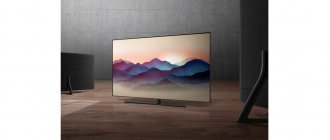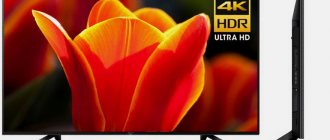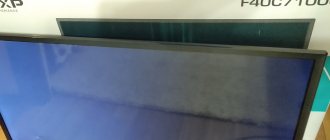When it comes to choosing electronic products, people usually look for Japanese products. They have a reputation for being high quality TVs.
At the same time, Korean manufacturers are not far behind in terms of reliability. A look at LG's electronic appliance brands confirms this fact.
Lak Hui (Lucky) Goldstar or simply LG as it is popularly called is a well-known player in the television market. They have a large presence in Russia, one of the most popular destinations for electronic goods, especially TVs.
Nowadays, most people have at least two televisions if not more in their homes.
LG has come up with the latest OLED TV models. Let's see what is in LG TVs
Features of LG OLED TVs
Can you guess what exactly OLED technology conveys?
Now everyone knows that LED stands for Light Emitting Diode. This part doesn't need any elaboration at all. Today there is a craze in the world for organic food, organic cosmetic products, etc.
Under these circumstances, is it safe to assume that “o” means “organic”? I must say that you hit the nail on the head. "OLED" stands for organic light-emitting diode.
Read more: Difference between LED and OLED TVs
OLED is a semiconductor made from an organic material that glows when you pass electricity through it. They call this effect "electroluminescence." When you use the word organic, it means that you have carbon as one of the main ingredients, accompanied by some other chemicals.
Each OLED pixel can create its own light depending on the amount of electrical current it receives. This means that more electricity means more light, while no electricity does not translate to "no light". This is the key to OLED's excellent picture quality.
OLED TV marketers claim that OLED technology can create infinite contrast. This is a fact, although it seems very difficult to believe.
OLED technology is the only one that can create perfect blacks. The contrast ratio is now defined as the brightest white divided by the darkest black. In the case of OLED, the denominator is zero. So, in theory, they are right when they claim that they can create infinite contrast.
Contrast ratio is one of the most important aspects of image quality. When you have technology that can create infinite contrast, it should produce the highest quality images.
Features of the 2021 model range
LG Alpha 9 Gen 3: The third generation Alpha 9 video processor is 15% faster than previous CPUs. Creates a good picture and high-quality sound, improves content of any type - with the help of artificial intelligence it scales the resolution to 8k. Due to its high performance, it allows you to successfully implement the functions of automatic configuration and content selection.
WebOS. A robust, embedded operating system that's great for browsing the Internet, has excellent social media integration, and is intuitive to use. WebOS implements multitasking, allows you to access Smart TV functions, and expands the TV's customization options.
Dolby Vision IQ. Latest video quality optimization feature that takes into account external light sources. Through the use of special sensors, Dolby Vision IQ adjusts settings and eliminates glare. Automatic adjustment allows you to change display settings depending on the content.
It will be easier to choose a TV if you first study the characteristics of the best models of different product lines. Here you should pay attention to both the advantages and
Which LG TV is better to choose?
Each OLED pixel is independent and can produce its own light source. Thus, it is the only technology available today that is capable of producing the darkest blacks and the brightest whites. This is the basic concept behind High Dynamic Range (HDR) technology.
No other LCD/LED TV is capable of producing this level of contrast. Although many people claim that plasma technology is the discovery of this century, this technology cannot produce the effects created by OLED technology.
Read: Samsung QLED and LED how to choose and which TV is better to buy?
A liquid crystal display (LCD) works by blocking the light produced by the backlight. These can be CFL bulbs or LED lighting.
LCD panels cannot block all light, thereby ensuring that they are unable to create perfect blacks.
With OLED technology, there is no question of any kind of backlighting, since the OLEDs themselves are light sources when electricity is applied to them. Therefore, an OLED TV does not have a backlight in the form of either CFL or LED. And you have more compact TVs compared to bulkier LCD/LED TVs.
Typically, you will find that the entire backlight in LCD TVs works as one unit. This means that screen dimming occurs across the entire screen. Today you have "local dimming LEDs" that can independently dim or brighten specific areas of LCD screens.
Read: OLED vs QLED, compare technologies and choose the best TV
Therefore, you can have, say, 6, or 12, or even 300 dimming zones on the screen. You will be amazed by the fact that the 4K OLED TV has over 8 million dimming zones.
How is this possible?
This is possible because OLED TV dimming works on a per-pixel basis. It may certainly lack the extreme output of some of the latest technologies like Samsung's Quantum Dot LED (aka QLED), but when it comes to the darkest blacks, nothing comes close to OLED technology.
Note: This post only applies to LG TVs and other TV technologies. We have also listed the best LED TVs , best 4K TVs , and best 32-inch TVs here .
Display technology
There are plasma screens, liquid crystal screens with backlights from a lamp or diodes, and, more recently, OLED screens based on organic light-emitting diodes. The screen type can be recognized by the letter immediately after the first two numbers indicating the screen size.
- E – OLED screen (from 2021 to 2021 OLED is designated by one letter, from 2021 by another marking, it is written about it further);
- U – liquid crystal matrix with LED backlighting and Ultra HD resolution;
- S – designation introduced in 2021, means “Super UHD” technology (best LCD models, backlight using Nano Cell quantum dots);
- L – liquid crystal matrix (LCD) backlit with light emitting diodes (LED) with HD resolution;
Not released today:
- C – liquid crystal matrix (LCD) backlit by a fluorescent lamp (no longer available);
- P – plasma panel.
What types of LG TVs are there?
LG's OLED display only uses two colors, blue and yellow. Using these color filters, they create red, green and blue colors. They have a transparent white element to increase the brightness factor.
Instead of making this part of the article too technical and difficult to understand, we will state that OLED technology is great for creating perfect blacks. QLED technology, pioneered by Samsung, is great for creating the brightest whites.
If you have a technology that combines the best of OLED and QLED, such as, say, pixels made from quantum dots, you could end up with the technology of the century. The day may be just around the corner when you can actually see the combination of OLED and QLED technologies.
Let's now move on to some other attractive features of LG OLED TVs before looking at some of the best TVs available in the market.
Display size
Everything is simple here. A TV is a device with a screen diagonal of 42 inches. For reference: 1 inch is 2.54 cm. The dimensions of the display have a direct impact on the price, so even a difference of a few inches can have a significant impact on the cost.
The fastest-selling models are with a diagonal of 32-50 inches. More and more buyers are opting for 55-inch screens. Therefore, the LG 42... TV, which we indicated in the example, is an average model in terms of these characteristics.
Technologies in LG TVs
HDR has become the talk of the town for advanced TV viewing today. In the old days, people talked about the concepts of the brightest colors, etc. Today you have concepts like the darkest blacks and the brightest whites. Plus you have natural colors.
This is the essence of HDR, more dynamic contrast, higher brightness levels and a wider range of colors. You end up with realistic pictures. HDR ensures that it enhances picture quality and brings out details that you usually miss on a traditional LCD/LED TV.
Read: What is HDR video technology?
LG can lay claim to being the pioneers of television innovation. Proof of this is OLED technology with HDR and Dolby Vision. The thing about OLED is that it is an emission technology compared to the transmission technology that QLED represents. When we use the word emissive, we are repeating that OLED pixels emit their own light instead of relying on the luminescence of the backlight.
Normal HDR LCD/LED TVs produce 14 stops of brightness, while the multi HDR OLED concept continues to produce 21 stops. This allows you to view images with a greater sense of clarity. Combine it with Dolby Vision technology and you get the power of Hollywood studios on your OLED TVs.
Model overview
When thinking about which TV to buy, consumers study many descriptions of various models, are interested in what position it occupies in the rating, as well as what other users who have already tested it think about a particular device.
This is a 2021 3D TV with circular polarization. Both lenses in glasses have different directions - clockwise and counterclockwise, in which changing the tilt of the head does not affect the depth of the 3D effect.
Specifications:
- The 32″ screen diagonal is most in demand among middle class consumers. Although 42″ and 55″ are available with similar characteristics, but then the price increases accordingly.
- The screen resolution is 1920×1080.
- The device is a 3D TV with LED backlighting and passive 3D technology.
- Smart TV support is based on the WebOS 2.0 platform. Connecting external devices is very convenient.
- The device is equipped with two TV tuners - analog and digital.
- Rated power consumption - 70 W. And in standby mode - 0.3 W.
The IPS matrix provides a wide viewing angle. The main menu contains all services and content for entertainment. According to consumers, this is one of the best 3D TVs from LG. With fairly good characteristics, it remains affordable.
This device is an ULTRA HD 4K TV. It is equipped with a digital DVB-T2 tuner and has a Virtual Surround sound system.
Positive characteristics:
- Incredibly clear Ultra HD screen.
- The unique 4K Upscaler algorithm allows you to scale the image to maximum clarity.
- The Motion Eye Care light sensor ensures that your eyes don't get tired while watching.
- Clear Voice II technology allows voices to be heard clearly and loudly.
- USB ports (2 pieces) and HDMI connectors (2 pieces) allow you to connect various external devices.
This LG 40″ TV model has won the love of many consumers.
According to experts, this model is the golden mean in terms of quality and price. The TV has a stylish design, and the quality of internal and external workmanship is at a high level.
Functions and Features:
- The particularly thin ULTRA Slim design with innovative metal elements in the body saves space and fits seamlessly into any interior.
- The HDR Pro feature allows you to view the rich color gamut, down to the smallest shades, that were intended when shooting the material. This is possible thanks to three-dimensional color processing.
- It is possible to increase or decrease the screen brightness to save energy.
- A special sound wave conversion system creates the impression that the sound is 7-channel.
- An updated set of programs based on webOS 3.0 significantly improves the performance of Smart TV.
Consumers give this LED TV from LG high marks.
This model is called the technology of the future in the world of images. She's incredibly stylish. This is the first ever OLED screen to be embedded in 2.57mm thick glass.
Model features:
- The TV is held on an elegant stand with a built-in soundbar (a special electro-acoustic device with or without a built-in subwoofer, designed to improve the sound capabilities of the device).
- OLED HDR provides a high range of brightness colors and is fully compatible and compliant with Dolby Vision standards.
- This device has achieved an unprecedented level of white to black ratio. Thanks to self-illuminating pixels, perfect black color can be achieved.
- The innovative display lacks internal backlit overlays and multi-layering, which is reflected in its thickness and weight.
- Magik Zoom technology makes it possible to enlarge a certain part of the screen to view the image in great detail.
Such OLED models are the hallmark of the Korean company.
A review of LG TVs shows that even their budget models are equipped with modern technologies. What can we say about luxury devices? From this manufacturer, everyone can choose a TV based on their financial capabilities.
Attention! decoding does not always provide absolutely reliable data, LG may change the labeling, but we tried to take into account different options. Read the detailed description with explanations below.
A full description of how this is done, plus obtaining online information about the marking of your model.
Which LG TV display is better to choose?
The Nano Cell Display is another wonderful technological innovation from LG. This technology uses uniformly sized particles approximately 1 nm in diameter to display accurate colors. You get a bright display that results in a flawless picture even when you watch the TV at an angle of up to 60 degrees.
These nano cells can absorb unwanted light wavelengths thus enhancing color purity. You have an amazing 4K screen to visualize the great result. Nanoelements are capable of producing image content 64 times richer than that of a conventional TV.
They are capable of producing more than a billion shades of colors. LG IPS 4K Nano Cell Display technology is capable of reproducing countless shades of color with finer degradation, allowing you to view an accurate color display at wider viewing angles.
Read: What is NanoCell technology?
You don't experience the usual problems of LED TVs such as color fading, image instability and other degradation issues.
In addition to the Nano Cell display technology, you have ULTRA Luminance technology that transfers excess current from darker areas, thereby increasing contrast levels. You end up seeing sharper, clearer images. All LG panels have this technology. LG is a pioneer in this technology. This is evident from the fact that LG supplies panels to its competitors such as Sony and Panasonic.
What operating system is on LG TV
The best thing about computer monitors is that you can see multiple scenes on one screen. The WebOS operating system supports this type of multi-viewing on LG OLED TVs.
The operating system has great functionality, as well as voice commands. You can use it as a universal remote control to control other compatible LG devices. Operating the LG Magic Remote is very easy due to the clear button demarcation.
You have additional speed dial functionality for your favorite channels in the same way as you do on your smartphone. This ensures that access to your favorite channel is just one click away.
TOP LG NanoCell models
1
TV NanoCell LG 65NANO996 65″
Rating:5.0
- 8K (7680×4320), HDR
- screen diagonal 65″, IPS
- Screen refresh rate 100 Hz
- Smart TV (webOS), Wi-Fi
- sound power 60 W (2x10 + 4x10 W)
Average price: RUB 224,999
Excellent image quality, bright, rich colors are realized using NanoCell technology. The amazing realism of the video sequence is complemented by excellent surround sound, which creates the impression of complete immersion in what is happening on the screen. The feeling of presence will definitely appeal to fans of video games.
- Energy saving options help reduce electricity consumption;
- The voice recognition function, complemented by ThinQ AI technology, works even at relatively long distances;
- The light sensor, together with the Dolby Vision IQ function, allows you to adjust the picture to external lighting conditions;
- Motion Pro option eliminates blur when displaying fast movements;
- Upscaling to 8k format.
2
TV NanoCell LG 65NANO956 65″
Rating:4.9
- 8K (7680×4320), HDR
- screen diagonal 65″, IPS
- screen refresh rate 50 Hz
- Smart TV (webOS), Wi-Fi
- sound power 40 W (2x10 + 2x10 W)
Average price: RUB 169,990
Unique color purity is achieved through the use of NanoCell technology. Fast video processing, smooth movements, high-quality pictures with excellent implementation of 8k resolution are achieved using the latest generation Alpha 9 processor. The built-in webOS operating system gives access to SmartTV options, LG TV channels, and a large amount of interesting content. Additional features: music search, support for 37 languages, parental mode.
- It is possible to connect via Wi-Fi, Bluetooth, LAN, four HDMI, three USB inputs and other connectors;
- Incredible sound clarity and depth with Dolby Atmos;
- Built-in intelligent technologies for content recommendation, voice recognition, and work with external connected devices;
- 12 month warranty.
3
TV NanoCell LG 55NANO906 55″
Rating:4.8
- 4K UHD (3840×2160), HDR
- screen diagonal 55″, IPS
- Screen refresh rate 100 Hz
- Smart TV (webOS), Wi-Fi
- sound power 20 W (2x10 W)
Average price: RUB 74,990
In this model, NanoCell technology, by filtering light waves of certain wavelengths, allows you to achieve excellent image clarity, high contrast, and obtain bright, saturated colors. Good black depth allows you to achieve better image realism and get even more pleasure from watching your favorite films.
- Wide viewing angles due to the use of an IPS matrix;
- ThinQ AI implements voice control not only for the TV, but also for compatible devices;
- Interaction with virtual assistants Alexa and Google Assistant has been implemented;
- Music recognition option available;
- Optimized system for content analysis and recommendations;
- Convenient Magic Remote.
4
TV NanoCell LG 55NANO866 55″
Rating:4.7
- 4K UHD (3840×2160), HDR
- screen diagonal 55″, IPS
- Screen refresh rate 100 Hz
- Smart TV (webOS), Wi-Fi
- sound power 20 W (2x10 W)
Average price: RUB 59,830
Good TV for its price. The advantages of the device include: good contrast, acceptable peak brightness, wide color gamut, excellent image clarity and detail. The acoustics of the TV are also excellent - the mid and high sound frequencies are well balanced. Even with slight harmonic distortion, audio quality remains acceptable at any volume;
- Good viewing angles;
- No glare in moderate lighting;
- Motion Pro ensures clear images even in the most dynamic scenes;
- The WebOS platform is simple and easy to use;
- Voice recognition function available;
- Gray uniformity is not good enough, darkening is observed at the edges of the screen.
5
TV NanoCell LG 49NANO866 49″
Rating:4.6
- 4K UHD (3840×2160), HDR
- screen diagonal 49″, IPS
- Screen refresh rate 120 Hz
- Smart TV (webOS), Wi-Fi
- sound power 20 W (2x10 W)
Average price: RUB 49,990
In this model, a bright, saturated image is achieved through the NanoCell filtration technique. The finest particles eliminate inaccurate shades and enhance the purity of color display. Contrast modulation technology allows you to get 4k images of maximum quality.
- Improved video and audio quality due to the modern α7 Gen 3 processor;
- Proven photobiological safety of the screen, confirmed by international studies;
- High contrast due to the Nano Black function;
- Intelligent adjustment of image parameters depending on the content;
- Advanced HDR formats - HLG and HDR 10 - create rich, vibrant, lifelike UHD images.
What parameters should you use to choose an LG TV?
When you compare a range of TVs, you use many parameters. One of these parameters is the refresh rate.
The refresh rate is the rate at which the TV refreshes frames per second. Typically this frequency is in the range of 50 Hz to 60 Hz. Different TV manufacturers classify it differently. Samsung calls it "Clear Motion Rate", while LG markets the same thing as LG TruMotion Rate.
This speed is very useful when you witness fast-paced scenes such as sporting events and action movies. LG TruMotion rate allows you to see the smallest details with the greatest ease.
The thing about LG TruMotion speed is that it has the ability to scale the refresh rate and keep up with faster programming, thereby cutting out motion blur.
Features of the TV line 2021
There's plenty to choose from in the products listed below, but LG's QNED (Quantum NanoCell Emitting Diode) Mini LED TVs might be the most exciting. In fact, it may be the most impressive LCD TV ever made, combining LG's NanoCell filtering technology with quantum dot color enhancement and a mini-LED backlight. Although it's not OLED.
LG OLED Evo
It has long been argued that OLED technology has reached its technical peak, resulting in a slow pace of improvement, but LG appears to be pushing back on that claim with its new OLED Evo panel.
OLED Evo features a new luminous material in the panel structure, resulting in brighter, clearer images. LG also promises greater detail and clarity. The Evo is a big improvement on the panel, with LG claiming it represents the "second evolution" of the LED, the first being the move to 4K/HDR in 2015.
The new Evo panels use organic LEDs from Dupont. They have lower excitation voltage and longer service life. As is known, for greater brightness of the LED, more voltage must be applied, and this reduces the operating life. Now these indicators have improved.
This all sounds very exciting, but one minor disappointment is that you have to buy a G1 TV to get the Evo panel. Unlike previous years, the C-class TV (that's the C1 in 2021) doesn't offer the best picture quality from LG.
As for whether other manufacturers will be able to use the new Evo panel for their TVs (LG currently supplies all OLED panels used in the industry), LG has not said at this time.
Alpha 9 Gen 4 processor
To no one's surprise, LG's 2021 TVs feature a new version of the Alpha 9 processor. Predictably called the α9 Gen 4, it has the same AI enhancement features, clearer text, automatic genre selection, and picture optimization. But it also updates several existing features and offers two completely new features.
Updated features are object enhancement, which now goes beyond faces to recognize and enhance entire bodies and objects such as cars and animals, and stereo audio mixing, which can now be done up to 5.1.2 channels rather than 5.1.
Brand new features, meanwhile, are scene detection, which automatically optimizes the picture for each scene, and automatic volume leveling, which ensures a consistent volume level when switching between channels and sources.
The idea is that all of these technologies work together to automatically get the best picture and sound from all sources. For example, it will detect that you're watching a movie on TV, then that it's a night scene, then detect and enhance individual objects, and then boost the audio level to 5.1.2. Switch to watching the news and it will instead enhance the on-screen text and switch to “clear voice” to make dialogue more intelligible.
Also built into the Alpha 9 Gen 4 processor, but not specifically tied to any of these AI features, are improvements to de-contouring, which should result in less color spread, and to the dynamic tone mapping algorithm, which, according to LG says this results in better contrast and less ghosting around bright objects.
LG webOS 6.0
LG's WebOS is one of the best operating systems for TVs, so it's no surprise that each new iteration is more of an evolution than a revolution. However, 2021's WebOS 6.0 is more of a throwback than an evolution.
Most notably, pressing the Home button no longer brings up a row of apps that overlap whatever you're watching, but instead takes you to a full-screen main menu dominated by content recommendations from various streaming services. The idea is that it's less about hovering over or clicking on a specific app to find something to watch (though there's still a line dedicated to apps just below specific content suggestions), and more about the content that's found front and center.
This is great in theory, but some service providers don't want their content included in such aggregators. In our review of the LG G1, we found that Netflix was missing from the recommendations on the LG main menu. The validity of the recommendations also seems questionable: you haven't had enough time with the TV yet for it to fully learn your viewing tastes, but it seems odd that the set would recommend a show for very young children at 8:00 p.m.
While it's obvious that more work is needed, we like the new main menu overall, and we miss the app pop-up bar less than expected. LG also deserves credit for finally overhauling the settings menu. The rather ugly and confusing menus of the past have been replaced by a system with larger fonts, a less restrictive white-on-gray color scheme, and a much more logical layout, all without sacrificing performance customization options.
LG webOS 6.0 interface
New Magic Remote
After several years of use, LG's original Magic Remote has finally retired, giving way to a new model.
At first glance, the modern Magic Remote looks less sleek and stylish than the old one, but it does feel nicer in the hand, still works great as a pointer, and has better and more buttons.
These new buttons include dedicated buttons for Google Assistant and Alexa, as well as other buttons for direct access to streaming services (the illustration shown shows shortcuts for Netflix, Amazon Prime Video, Disney+ and LG channels, but these will vary slightly by region ).
Magic Remote
Game modes
It's fair to say that LG's OLEDs are already some of the best gaming TVs available, and the company is looking to push things further in 2021. HDMI 2.1 connections with ALLM (Auto Low Latency Mode), VRR (Variable Refresh Rate) and HGiG support remain. But a new Game Optimizer menu has been added to allow gamers to quickly enable or disable certain gaming features such as G-Sync and Freesync. From this menu you can also choose from specific game genres and even adjust the amount of blue light produced.
The company talks about a genre select feature that provides the best settings for the specific type of game you're playing, but of course, we all just want the lowest input lag, the sharpest definition, and the most accurate colors, and that should be regardless of genre. Users still prefer to enable HGiG and use your console's (and games') video calibration features to get the most accurate performance.
One of the undeniably neat additions to LG's 2021 models is the integration of Google Stadia's cloud game streaming service. These will be the first non-Android TVs to have Stadia built-in.
Characteristics of LG TVs
Who would want to have a TV that wears out quickly due to its thin design and use? LG understands this concept better than others, as it provides comprehensive protection for each of its TVs. Let's look at some of the steps LG has taken in this regard.
LG's In-Plane Switching Panels (IPS) today are able to withstand a range of temperature and pressure changes. You need such a variety of equipment due to the vast geographical area of Russia. You have cities that experience different temperatures throughout the year.
In Russia, deep voltage fluctuations sometimes occur. Consequently, LG TVs are capable of withstanding voltages ranging from 100 V to 240 V.
You may experience unexpected lightning surges. Consequently, LG TVs today are armed with a 500V cap, fuse, varistor, thermistor and insulator for protection.
The dust vents on the back cover have also been improved over time to prevent dust from getting into the TV's mechanisms.
You must have heard about the mosquito repellent advertisements that are often played on TV. Have you ever heard of a TV with mosquito repellent?
LG pioneered this mosquito removal technology that uses ultrasonic waves to keep mosquitoes away. This way, you don't need to use mosquito repellents that rely on harmful chemicals. LG is the first TV manufacturer to include this feature on its high-end TVs.
Tuner designation
The last letter in the LG TV marking indicates the type of tuner for signal reception.
- T — tuner formats DVB-T/T2, DVB-C;
- S — tuner formats DVB-T, DVB-C, DVB-S/S2;
- V — tuner formats DVB-T/T2, DVB-C, DVB-S/S2;
- C—tuner formats DVB-T, DVB-C.
An example of decoding the labeling of an LG TV until 2021
For example, let's take the LG 49SJ810V model. What can you learn from this label? Let's look at it in order:
- 49 – diagonal size in inches;
- S – TV with a liquid crystal matrix and quantum dot backlight with 4K resolution (Super UHD);
- J – 2021 model;
- 8 – series number;
- 1 and 0 – modification of the 8 series (indicates the appearance and minor differences in parameters);
- V – information about the tuner.
Which TV to choose LG or Samsung
LG differs from other TV makers like Samsung, Sony and Panasonic in that it uses IPS instead of vertical adjustment (VA) panels. It is undeniable that VA can offer brighter picture quality. However, when it comes to viewing angles, nothing can beat IPS panels.
IPS panels are rated as the most durable. No other brand can match LG's versatility. Sony boasts uniform screen performance, but it does come at a price. Even Sony, with all its Japanese technology, can't match Korean conglomerate LG's versatility quotient.
Pros and cons of LG TVs
Before we look at some select LG models, we'll sum up LG TVs in a few words.
Starting on a positive note, LG offers designs that can withstand high voltages.
LG designs can keep up with the vagaries of the weather. You have positive features like TVs with anti-mosquito coating, high wave protection, etc. OLED technology provides an unparalleled movie viewing experience.
Negative aspects should also be noted. LG, for some strange reason, prefers to use IPS panels while its competitors have moved ahead with VA panels. IPS panels have a history of offering low contrast ratios.
However, despite this, LG is the leading TV manufacturer in Russia. These models are versatile and innovative in their own way. This company has been around for over two decades. Therefore, there is no shortage of quality in LG TVs. You can choose TVs from this brand. They are famous for their quality and reliability.
Best LG 4K TV
Model - LG OLED
55 inches - LG OLED 55B9P
65 inches -LG OLED65B9P
77 inches - LG OLED77C9P
Some characteristics and features of the models.
- OLED technology illuminates every pixel for unprecedented color and clarity. The richest details of each image can be observed. Experience the brightest whites and darkest blacks in this remarkable TV.
- OLED technology promises infinite contrast without any light leakage. This technology is currently not available on any other TV in this range.
- When you have perfect blacks and whites, you must also get perfect colors. The vividness of these images is literally the talk of the town.
- With nearly 8.3 million pixels, you get about 4 times the screen resolution of Full HD. You will be able to experience breathtaking clarity even at close range.
- WebOS 3.0 is the latest addition to the LG Smart TV platform. Advanced features create a pleasure to use.
- This is a TV recommended by Netflix. So you can watch Netflix movies with all their original features.
- OLED technology does not require any backlight. Hence, you can make these TVs as thin as possible.
- You have a sleek stand that comes with a built-in soundbar speaker.
- The Harman Kardon audio system is of the highest class.
LCD, plasma, OLED: advantages and disadvantages
Thus, today the company provides three main types of TVs:
- LCD (liquid crystal)
- such a screen consists of an LCD matrix (liquid crystals located between polymers), light sources, wires, and a housing that gives rigidity. Each “liquid crystal” is two layers of polarizing filters, between which are electrodes, and between them, in turn, is a layer of molecules. - Plasma (SED)
- so-called gas discharge monitors. Their work is based on the glow of a phosphor under the influence of UV rays. The latter arise during the passage of an electrical discharge. - OLED
is a type of screen made up of organic compounds that are capable of emitting light when an electric current passes through them.
Let's look at the main advantages and disadvantages of the presented LG TV models in the table.
| Variety | pros | Minuses |
| Liquid crystal displays | Low weight and size of the device. Unlike electron beam devices, there is no flickering, image focusing defects, or interference with the clarity and geometry of the transmitted image. Many models are characterized by obviously low energy consumption - it depends entirely on the power of the lamps or LED backlights. | A clear image is only possible with one resolution. Low image contrast, as well as black depth. Sometimes there is a problem of uneven brightness of the image. Practically not protected from mechanical damage. The “dead pixel” problem often occurs. Replacing fragile matrices is very expensive. Small difference in permissible operating temperatures. |
| Plasma TVs | Color depth. Uniformity of luminescence of black and white colors. Long service life (according to some manufacturers, up to 30 years). | Increased power consumption (compared to LCD monitors). Large-sized pixels imply the development of large-sized screens. Screen burn-in may occur in areas where a still image is displayed for a long time. |
| OLED displays | Light weight and dimensions. Low power consumption while maintaining high image brightness. Possibility of developing flexible displays. The ability to create TVs with giant screens. No need for backlighting. Wide viewing angle - the image is clearly visible from any angle. No inertia, instant response. High picture contrast. The screen can fully operate in a wide range: -40 ... +70 o C. | Short service life of diodes. Red and green compounds fade much more slowly than blue, which can significantly distort the color rendition of the image. The impossibility of creating durable 24-bit displays. High price combined with some imperfect technology |
Having analyzed the features of the presented ones, we move on to deciphering the markings.
Best Full HD SMART LG TV
Model-UM
43 inches - 43UM7090 43
49 inches - 49UM7090 49
50 inches - 50UM7300 50
55 inches - 55UM7450 55
65 inches - 65UM7450 65
You get this smart TV in 5 variants. Some characteristics and features of the models.
- These are full HD TVs with a screen resolution of 1920 X 1080 pixels. 2 million pixels give a decent picture.
- LG Smart TVs are equipped with a modern Magic remote control that is convenient to use. Connecting this TV with other devices is easy.
- Wi-Fi Alliance certified Miracast provides a seamless connection between your TV and other Wi-Fi enabled devices.
- This TV allows you to watch your favorite TV shows and movies.
- Switching to YouTubeTM to access unlimited video content is easy.
- Built-in Wi-Fi provides greater connectivity to other similar devices.
- The Clear Voice III feature separates out background noise, giving you crisp, clear sound.
- The metallic design makes it a stylish option for the living room.
- The slim design is the highlight of LG TVs. The narrow design eliminates space between the screen and the wall.
- This TV is energy saving. The TV does not use electricity in standby mode.
The best 4K TVs from LG
LG 55UN73006LA 55″
The IPS matrix with 8-bit color depth produces beautiful, vibrant images in true 4K. A powerful processor enhances contrast and removes noise, low-resolution video is automatically upscaled and brought to maximum quality, closer to 4K. The model supports Wi-Fi and Bluetooth. The game mode works without lags. The new webOS 5.0 provides greater opportunities for controlling a TV, and it can also be used to control household appliances in a smart home. Powerful loud sound is provided by two built-in speakers, 10 W each.
pros:
- Realistic picture;
- Thin frame;
- Large viewing angles;
- Magic remote control included.
Minuses:
- There are highlights in the corners.
LG 50NANO796NF 50″
An optimally sized 50″ TV with an S-mva matrix at a reasonable price, which produces the clearest and most realistic image possible.
There is a useful teletext function that allows you to read the news, TV program and so on. With the picture-in-picture option, multiple channels are displayed on the screen simultaneously. The powerful quad-core processor always correctly upscales images to 4K. A remote control pointer is included and allows you to control the TV using voice commands. Pros :
- Active HDR;
- Convenient stable stand;
- Support for Alexa and Google assistants;
- Virtual reality 360 VR;
- Surround sound.
Minuses:
- When viewed from the side, the image fades.
- Thick body.
LG 65UN73006 65″
Model 65″ with IPS matrix and powerful 4-core processor. The image is automatically scaled closer to 4K. This TV can become part of the Smart Home system. A remote control with a gyroscope and microphone is included. Voice commands are also sent to other home appliances directly through the TV. The model supports all audio and video formats and even HDR formats.
pros:
- Large contrast display;
- Instant response from the remote control;
- Incoming signal without delay;
Minuses:
- Low maximum brightness;
- Widely spaced legs.








